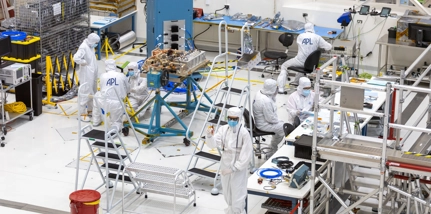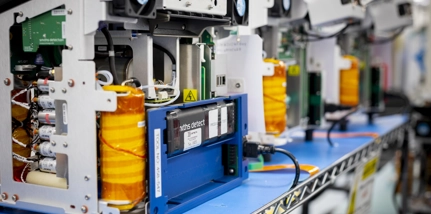
3 July 2024
The new frontline advantage in the war on drugs and organised crime
The UN’s latest World Drug Report is an uncomfortable read. One in 17 people aged 15–64 have used an illicit drug recently, representing a 23% explosion of the global user population over a decade.
In its wake has followed a rise in fatal overdoses, serious shared-needle infections like HIV and Hepatitis-C, and mental health issues, which are costing global health and social services trillions. And there are other significant impacts, from deforestation and displacement for coca-bush cultivation, to associated increases in crime.
Recent high-profile seizures – such as the £450m stash of cocaine hidden in banana crates at Southampton Port (UK) - highlight some victories within the war against drugs. But such gains require long and costly investigations. Between these, traffickers are finding nimble workarounds, including ‘small deliveries’ conveyed via carry-on bags and hold luggage.
AI and algorithms are helping detect narcotics
Current detection technology is already identifying illegal contraband. Indeed, the roll out of Computed Tomography (CT) scanners at major airports around the world (enabling passengers to leave laptops and liquids in their luggage) is testament to the increasing sophistication of threat detection innovation.
In addition, both conventional X-ray and CT scanners are using increasingly sophisticated AI algorithms to help them ‘recognise’ illicit cargo. Developed by crunching thousands of X-ray images to build a suite of identifiable traits for objects based on shape, texture, colour and density, this approach builds effective screening profiles for contraband items such as narcotics, explosives and weapons.
However, more needs to be done.
Lucrative 'fast parcel’ opportunity for traffickers
Whether for profit or to offer a new user experience, traffickers are increasingly cutting drugs like fentanyl, heroin and cocaine with other substances and packaging them to look like benign items. This makes it harder to identify them from AI libraries, so requiring time-consuming manual inspections to aid detection efforts. And now, the ‘fast parcel’ trend is providing criminals with yet another lucrative opportunity to exploit the same issue.
Pitney Bowes’ Parcel Shipping Index forecasts that, by 2026, parcel volume will likely reach 220-262 billion. That’s more than 8,000 parcels shipped every second through the world’s 13 major markets – and an increasing percentage are channelled through a premium delivery service to satisfy consumer demand for speedy fulfilment. Without effective automated detection systems, more illegal products will inevitably go undetected.
Enter...Diffraction
Crucially, Smiths Detection has pioneered a new solution utilising well-established technology: X-ray Diffraction (XRD). To explain, here’s a quick physics lesson.
Any wave, whether water, sound, light or electromagnetic will ‘bend’ or ‘scatter’ around a molecular structure or object it ‘bumps’ into.
This is diffraction – something we experience daily, whether in the way a river ripples around bridge piles, voices distort around corners or white light splits into its constituent rainbow colours on a pitted CD face.
Similarly, when X-ray waves beam onto a substance, its constituent atoms diffract them in different directions. Because each substance has a specific arrangement of atoms, the resulting scatter-pattern of the diffracted waves is unique to it – a ‘diffraction fingerprint’ if you will.
Since the early 1900s, scientists have capitalised on this principle to ‘map’ the unique diffraction fingerprint of different materials.
By measuring the angles and intensities of diffracted rays, they can characterise the atomic structure of new materials or discern between materials that appear similar in other experiments. Its precision famously helped to reveal the molecular structure of DNA in 1962, and today is used to advance numerous industries from microelectronics and construction to pharmaceutical development.
A new frontier in the war on drugs
Now, Smiths Detection is using XRD to offer new hope in the war on illicit cargo by accurately identifying products from their molecular structure.
Our transformative solution has a breakthrough design incorporating a multi-focus X-ray source that fans beams out across the whole screening tunnel, and multiple detectors that pick up the resulting diffracted waves and feed them into the system’s pattern analysis engine. This then processes them simultaneously to produce ‘fingerprint’ data that clears a substance or otherwise with an exceptional level of efficiency and accuracy.
And it’s not just narcotics, but a wide range of illicit cargo that this technology detects. For example, perhaps surprisingly, C4 plastic explosive has a very similar molecular density to Gouda cheese – offering a challenge when trying to detect whether a hold luggage bag contains an Improvised Explosive Device or merely a simple foodstuff. XRDs sophisticated technology accurately distinguishes the difference, even being able to specify the exact type of cheese contained in the bag.
Making travel even safer and more secure
The unique design allows the screening system feeder belt to keep moving while significantly reducing the need for manual inspection. Combined, this could see a tenfold increase in the throughput of hold luggage or parcels, while boosting drug detection rates and deterrent effectiveness.
Crucially, because the system is implemented in the hold area, screening luggage after the check-in process, the new XRD technology won’t change passengers’ pre-flight experience. They can continue to enjoy a meal or shopping in the knowledge that, below deck, this powerful new addition to the border-force armoury is working on their behalf to make travel safer and more secure than ever.
All this makes it an important addition to the border-force armoury. One which might finally turn the tide of the war on drug traffickers, as well as other forms of organised crime.
Related insights

Searching for E.T.
Read our latest Engineering Explained insight on Smiths Interconnect's role in NASA’s Europa Clipper - to search for life on the fourth largest of Jupiter’s 95 moons.
Find out more

Integrating a sustainable ethos into our products
Find out more

How our engineers are helping hydrogen to become a source of new energy
Read our latest Engineering Explained insight piece on how our engineers are helping hydrogen to become a safe, secure and profitable source of new energy
Find out more


